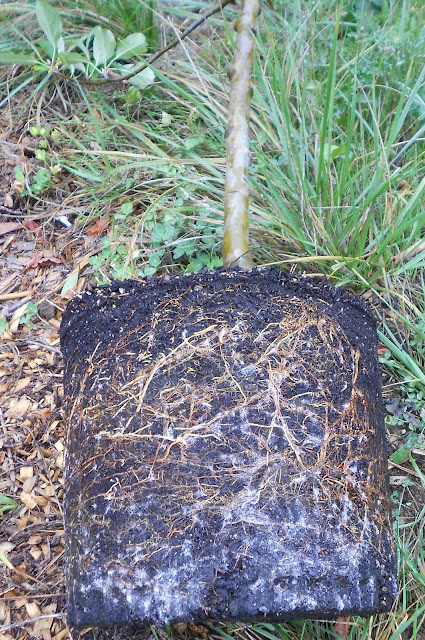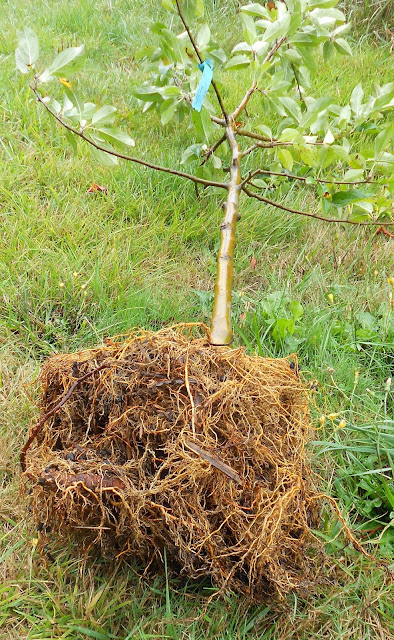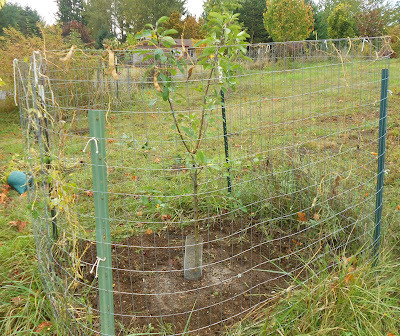 |
| Gravenstein Apple Tree in Container. 10.2.16 |
This is a containerized Gravenstein apple tree that I bought on Fall sale at a local nursery. I wanted a Gravenstein after tasting some neighborhood apples identifed as that cultivar.
A few of my orchard trees have been killed in their first year, by gnawing rodents that remove virtually all of the roots up to the graft. I strongly suspect voles, which are gnawing herbivores that do eat roots and bark. I have read that voles use mole tunnels to travel around and access roots. Often, my small trees have been surrounded by mole hills and therefore mole tunnels, from shortly after planting. I suspect the voles have used those mole tunnels to do their dastardly deeds, murdering my baby fruit trees.
What is the attraction for moles, to the roots of these trees? Moles are predatory carnivores. They eat bugs and worms. Again, I don't know for certain, but my guess is that the rich planting compost in the tree containers, is a boon for worms and bugs. Which then attracts moles, who eat the bugs, leaving tunnels for moles who eat the roots and bark.
For entirely different reasons, horticulturalist
Linda Chalker Scott strongly recommends bare-rooting new containerized trees prior to planting. She also recommends bare-rooting balled-and-burlapped trees. Doing so, allows correction of time-bomb flaws that can kill a tree several years down the road.
 |
| Apple Tree Roots in Conntainer Medium. 10.2.16 |
Those flaws include girdling roots, deep within the root mass, not visible when the tree is pulled from the container. That's in addition to winding roots that grow around and around against the plastic of the pot. Bare-rooting also removes a transition between the container medium and the native soil, which can adversely affect tree root growth. When replanted, the tree's roots are now in full contact with native soil, no artificial transition between clay (balled and burlap trees) or planting compost (most container trees) or worse, both (often box box stores have trees which are balled and burlap, placed into compost in containers to sell - 2 bad transitions for the roots to deal with).
I've always cut off winding roots, and often make incisions deep into the container soil, but almost never bare-rooted a tree. What's more, this tree is in full leaf.
This being fall, today was rainy and overcast, temperature in the 60s. I thought, not bad for a brief period of naked tree roots.
 |
| Roots After About 5 Minutes of Hosing Off. 10.2.16 |
 |
| Roots After About 10 Minutes of Hosing Off. 10.2.16 |
 |
| Bare-Rooted Apple Tree. 10.2.16 |
Roots had not wound too much around the pot. The tree was not root bound. I set the hose on "jet" - not a bark-removing strength, I hope, but strong enough to wash most of the medium from the roots. I did not use garden tools to unwind roots, just water and my fingers.
The washing process required about 10 minutes, wash, turn, wash, turn, wash, etc. I don't think the roots need every last scrap of soil removed, just the best that I can do.
After some minor root pruning, I planted the tree in it's selected spot. The level is the same as in the container, with the graft a bit about 3 inches or so above soil level. I watered the soil in around the roots, with the hole about 1/3 full, 2/3 full, and finally when fully filled. The goal was to get the roots all well blanketed with native soil, as best as I could.
Vole guard (1/4 inch hardwar cloth) and deer cage (larger mesh fencing) are all in place. I've learned not to delay those protective measures.
 |
| Tree Planted with Graft a Few Inches Above Soil Line. 10.2.16 |
Mulch will follow. I'm thinking it will be grass clipping mulch, which packs down significantly during the winter and does not seem to provide warm dry fluffy homes for rodents.
Not a single leaf fell from the tree. I'll continue checking, but I think it won't miss a beat.
 |
| Tree Planted, Vole Guard in Place, Deer Cage in Place. |
